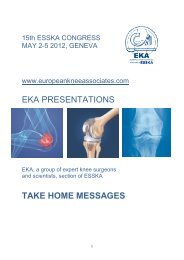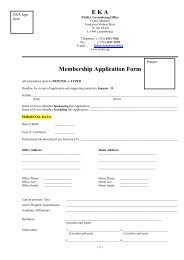Download the Take Home Message Book in PDF format
Download the Take Home Message Book in PDF format
Download the Take Home Message Book in PDF format
You also want an ePaper? Increase the reach of your titles
YUMPU automatically turns print PDFs into web optimized ePapers that Google loves.
HOW TO IMPROVE PATELLO-FEMORAL TRACKING WITH CURRENT TKA DESIGN<br />
TROCHLEAR CONSTRAINT ROLE<br />
Andrew Amis<br />
Imperial College, London, United K<strong>in</strong>gdom<br />
Key po<strong>in</strong>ts<br />
1. Near knee extension, patellar track<strong>in</strong>g and stability are controlled ma<strong>in</strong>ly by <strong>the</strong> soft tissues – <strong>the</strong><br />
quadriceps and ret<strong>in</strong>acula – and not by <strong>the</strong> trochlear geometry. Therefore, good track<strong>in</strong>g <strong>in</strong> early knee<br />
flexion depends primarily on soft tissue balanc<strong>in</strong>g.<br />
2. The natural trochlear groove has a prom<strong>in</strong>ent lateral facet which controls patellar lateral translation<br />
when <strong>the</strong> patella enters <strong>the</strong> groove around 20 degrees knee flexion.<br />
3. In general, <strong>the</strong>re will be a higher constra<strong>in</strong>t to control <strong>the</strong> patellar track<strong>in</strong>g when <strong>the</strong> trochlear groove is<br />
deeper and has a steeper slope on <strong>the</strong> articular facets.<br />
4. Patellar track<strong>in</strong>g follows <strong>the</strong> natural trochlear groove, which is aligned with <strong>the</strong> mechanical axis of <strong>the</strong><br />
femur.<br />
5. Modern pros<strong>the</strong>ses with grooves which are lateral near extension and medial near deep flexion are not<br />
anatomical and do not offer more physiological track<strong>in</strong>g or medial-lateral stability than did <strong>the</strong> older<br />
designs.<br />
6. Patellar track<strong>in</strong>g is also <strong>in</strong>fluenced by <strong>the</strong> position of <strong>the</strong> pros<strong>the</strong>tic femoral component: external<br />
rotation causes <strong>the</strong> patella to be carried laterally and to be tilted laterally.<br />
7. We may conclude that patellofemoral jo<strong>in</strong>t function after TKA depends on accurate implant alignment<br />
and soft tissue balanc<strong>in</strong>g. These surgical factors may be more important than <strong>the</strong> geometry of <strong>the</strong><br />
implant!<br />
39





